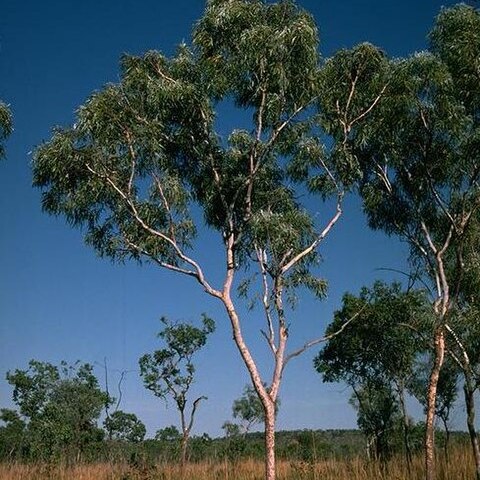Tree 10 m tall. Forming a lignotuber.Bark thin, rough, patchy, fibrous-flaky to tessellated, variably extending over the base to all of trunk, but predominantly smooth, slightly powdery or not, white to cream or pale grey.Branchlets lack oil glands in the pith; often whitish, especially new growth in crown, due to the rubbery cuticle, smooth.Juvenile growth (coppice or field seedlings to 50 cm): stems rounded to square in cross-section, setose with bristle-glands to ca 3 mm long and with sparse microscopic white simple hairs also; juvenile leaves always shortly petiolate, opposite for many nodes, cordate to ovate, 5.5–13(17.7) cm long, 4–7(8.5) cm wide, base lobed to rounded, rarely peltate, apex rounded and apiculate or broadly pointed, green, with sparse bristle-glands and white simple hairs densely distributed on both surfaces, the density decreasing up the stem; by ca 0.8 m tall stems and leaves suddenly become glabrous and also whitish due to rubbery cuticle. Crown of adult leaves with new growth distinctly silver-white, conspicuous from a distance.Adult leaves alternate, petioles 1–3.7 cm long; blade lanceolate to falcate, 9.2–23.5 cm long, 1–3 cm wide, base tapering to petiole, margin entire, apex pointed, concolorous or only slightly discolorous, maturing glossy, green, smooth, side-veins greater than 45° to midrib, reticulation very dense, intramarginal vein not visible (contiguous with margin) or only just visible, oil glands present, island.Inflorescence terminal compound, peduncles stout, 0.5–3.5 cm long, buds 7 per umbel, stoutly pedicellate (pedicels 0.5–2.8 cm long). Mature buds ovoid (1.3–1.6 cm long, 1–1.1 cm wide), smooth, often appearing whitish, scar absent (both opercula shed together at flowering), operculum rounded to bluntly conical, stamens inflexed, all fertile, anthers oblong, dorsifixed, versatile, dehiscing by longitudinal slits, style long and straight, stigma blunt and papillose, locules 4, the placentae each with indistinct ovule rows, the cluster moderately large. Flowers creamy white.Fruit pedicellate (pedicels 0.5–3.5 cm long), thick-walled, barrel-shaped and not or only slightly contracted to form a neck, the rim not flared, 2.6–3.7 cm long, 1.8–2.5 cm wide, longer than wide, smooth, disc descending vertically, valves 4, enclosed.Seeds brown, 9–13 mm long, ellipsoidal with terminal wing, hilum ventral. Cultivated seedlings (measured at ca node 10): cotyledons reniform; stems rounded in cross-section, setose with bristle-glands and also with short white simple hairs on the epidermis; leaves always petiolate, opposite for at least 13 nodes, ovate to cordate, 5–10.5 cm long, 2–5 cm wide, base rounded on lower leaves, lobed higher up stem, dull, green, sparsely setose, and with a carpet of short white simple hairs on both surfaces.
More
Tree to 18 m with a short trunk and widespreading branches. Bark thin, tessellated, grey, yellow-brown or orange on trunk and often on base of larger branches, smooth and white above. Juvenile leaves petiolate, ovate-lanceolate, scabrous. Adult leaves usually subopposite, lanceolate, acuminate, thick; lamina 12–18 cm long, 1–2.5 cm wide, silvery when young, concolorous; lateral veins numerous, faint, at 70°–75°; intramarginal vein confluent with margin; petiole 10–25 mm long. Umbels 3–7-flowered; peduncle thick, terete, 8–12 mm long; pedicels thick, 12–17 mm long. Buds ovoid; operculum hemispherical, 6–8 mm long, 10–14 mm wide; hypanthium hemispherical or truncate-ovoid, 10–12 mm long and wide. Fruits long-pedicellate, ovoid, 3–4 cm long, 2–2.5 cm wide. Seeds winged at one end, yellow-brown.


